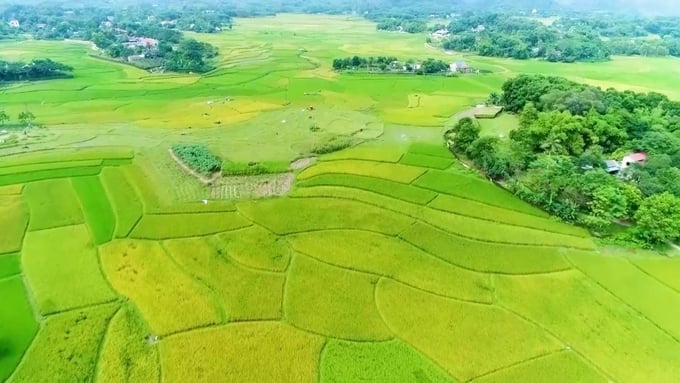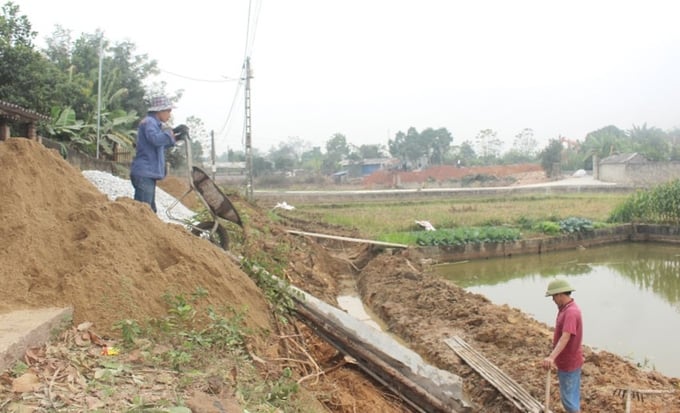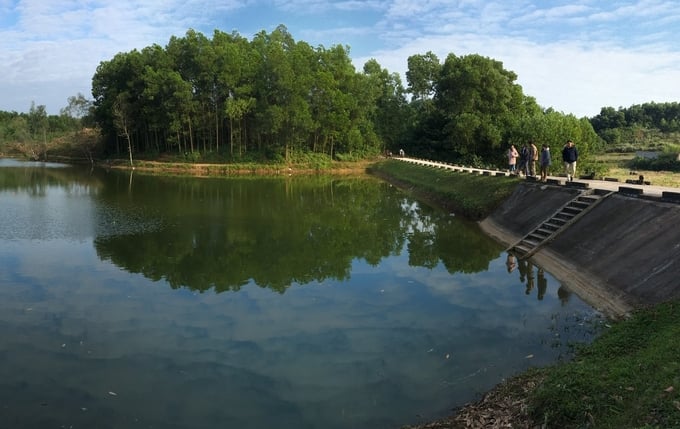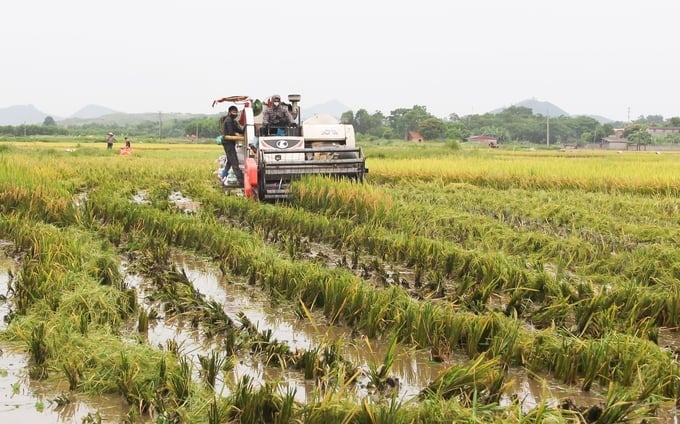May 24, 2025 | 03:44 GMT +7
May 24, 2025 | 03:44 GMT +7
Hotline: 0913.378.918
May 24, 2025 | 03:44 GMT +7
Hotline: 0913.378.918

Song Cong city is focused on renovating and upgrading irrigation structures, dredging internal canal networks to meet agricultural production demands. Photo: Pham Hieu.
Song Cong city in Thai Nguyen province is focused on renovating and upgrading irrigation structures, dredging internal canal networks to meet agricultural production demands, thererby promoting safety and enhancing the disaster resilience of local structures during the rainy season.
According to the residents of Tan Quang commune, Song Cong City, the water collection pit of the Dong Tien pumping station was previously narrow, extending the water pumping process by several days during the planting season, affecting approximately 70 hectares of agricultural production land in the local community.
However, according to Mr. Pham Anh Tuan from Dong Tien hamlet, Tan Quang commune, the city invested over 570 million Vietnamese dong in April 2023 to repair the water collection pit and water channels. Subsequently, the project was put into operation by the end of May 2023, facilitating the production activities of local residents.
Song Cong city has invested approximately 8.5 billion Vietnamese dong since 2022 in the renovation and upgrade of nine irrigation structures across various communes and wards. Regarding the internal canal network projects, in addition to mobilizing local residents to participate in the construction, the local government has implemented a support mechanism covering 40% of the project value for wards and 60% for communes.

Song Cong city has invested approximately 8.5 billion Vietnamese dong since 2022 in the renovation and upgrade of nine irrigation structures across various communes and wards. Photo: Pham Hieu.
Between 2019 and 2021, Song Cong city invested nearly 30 billion Vietnamese dong, which was drawn from various funding sources, to repair and upgrade 40 local irrigation structures. Notable projects include the upgrade of the Nuc Nac reservoir in Chau Son ward; the construction of the new La Canh 1 water pumping station and Na Giang in Ba Xuyen commune, and the Ba Van 4 water pumping station in Binh Son commune; the construction and repair of over 20 kilometers of canal networks in various communes and wards.
The Van Han water reservoir is one of the major irrigation structures in Dong Hoi district. After receiving approval for the investment plan from the Provincial People's Committee in 2017, the project was implemented, including key components such as the construction of dam, flood discharge spillway, control room, lakefront road, and canal network system, with a total investment capital of 90 billion Vietnamese dong. To date, the project has been put into effective operation, ensuring irrigation water for over 300 hectares of agricultural land in Van Han commune and neighboring regions.

Between 2010 and 2020, Dong Hoi district has reinforced nearly 45 kilometers of internal canal networks. Additionally, there have been the construction of new structures, repairs, and upgrades to 43 irrigation nprojects, involving a total investment exceeding 40 billion VND. Photo: Pham Hieu.
According to Mr. Luong Van Hoan, Vice Chairman of the Van Han Commune People's Committee, the completed irrigation structures ended the prolonged droughts affecting local agricultural fields. The Van Han reservoir currently holds water and provides irrigation for 120 hectares of two rice crops, 50 hectares of winter crops, and 70 hectares of tea, fruit trees. Additionally, the structure is serving the domestic water needs for residents and livestock. Consequently, the project plays a role in ecological environmental improvement and flood control.
The reinforcement project for the internal irrigation structures in the villages of Lang Lam and Trung Than in Hoa Trung commune in 2021, with a total investment capital of nearly 1.9 billion Vietnamese dong, has been completed. Subsequently, the project has provided an irrigation water supply for 85 hectares of rice in the two villages.

Due to proactive management of irrigation water sources, several concentrated rice production areas with large fields have been established within Dong Hoi district. Photo: Pham Hieu.
"Reinforcing the irrigation infrastructure system not only reduces the cost of water pumping, conserves irrigation water, and prevents wastage that would otherwise burden the locals, but also allows the local community to proactively manage their production during each cropping season," shared Mr. Tran Duc Long, a resident of Trung Than hamlet.
According to statistics, the district received an investment funding of over 30.7 billion Vietnamese dong between 2020 and 2022, to construct, repair, and upgrade 20 irrigation structures, and reinforce 23.5 kilometers of internal canal networks.
Translated by Nguyen Hai Long

(VAN) The People's Committee of Tra Vinh province has approved an adjustment to the investment policy for the Green Hydrogen Plant project, increasing its area to approximately 52.76 hectares.
![Reducing emissions from rice fields: [2] Farmers’ commitment to the soil](https://t.ex-cdn.com/nongnghiepmoitruong.vn/608w/files/news/2025/05/05/dsc08881jpg-nongnghiep-140632.jpg)
(VAN) Clean rice cultivation model in Thuong Tan commune, Bac Tan Uyen district, is assisting local residents in achieving sustainable agriculture by substantially reducing costs, increasing productivity, and protecting the environment.

(VAN) At the conference to disseminate Resolution No. 68, AgriS introduced its digital agricultural ecosystem and reaffirmed its commitment to accompanying the Government in promoting private sector development and sustainable agriculture.

(VAN) 'Blue Ocean - Blue Foods' initiative is designed to restore marine ecosystems and establish sustainable livelihoods for local communities by cultivating a minimum of 1,000 hectares of cottonii seaweed in the first three years.
/2025/05/21/4642-3-112707_603.jpg)
(VAN) The V-SCOPE project has made direct contributions to three out of six pillars of the Comprehensive Strategic Partnership between Vietnam and Australia.

(VAN) Facing the threat of rabies spreading to the community, Gia Lai province urgently carries out measures to vaccinate dogs and cats on a large scale.

(VAN) Disease-free livestock farming not only protects livestock herds but also stabilizes production and livelihoods for many farmers in Tuyen Quang.